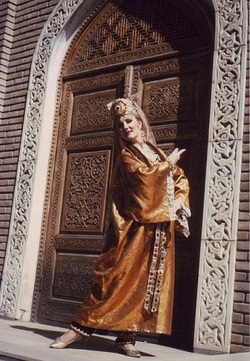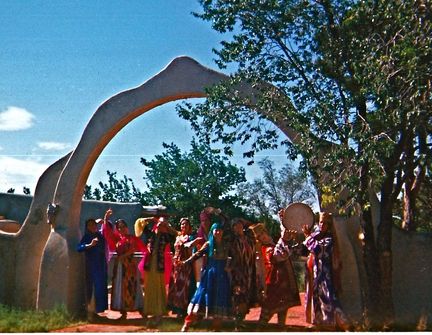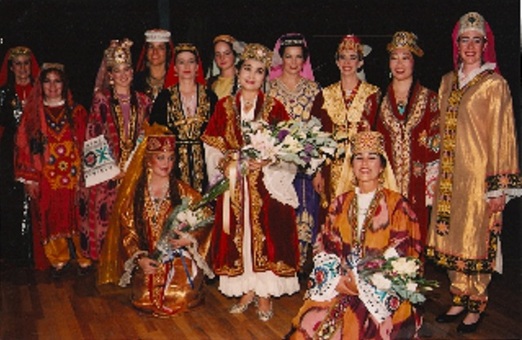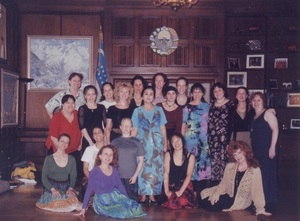Press about Past Uzbek Dance and Culture Society Events
Uzbek Independence Celebration in Washington DC
Silk Road Dance Company performed at Embassy of the Republic of Uzbekistan in celebration of 20 years of independence. The gala concert included the musical ensemble ''Registan'' from Tashkent. The VOA broadcast of the event included footage of Silk Road Dance Company performing Babur Gazal, Lazgi, Lagan and Dil Kroch.
BBC Interview about Uzbek Dance with American dancer Laurel Victoria Gray

This Uzbek language interview covers a variety of topics on Uzbek dance, including a discussion of Americans' interest in the genre.
1997 Central Asian Dance Camp

August 7 - 10, 1997
by Linda Swanson
Peshanabands!
Each day after lunch we sat outside under the big clear New Mexico sky and made our own peshanabands (those elaborately decorated banded crowns with veils worn by dancers in Bukhara)! Surrounded by boxes of richly colored fabrics, glittering trims and gaudy/elegant trinkets, we let the morning choreographies sink into our bodies even as they were resting for the afternoon's study...
Such was the rhythm of the 2nd annual Central Asian Dance Camp held August 7-10 outside of Santa Fe, New Mexico—four wondeful days immersed in this vitally connective dance.
Laurel Victoria Gray taught two complete and very different choreographies—Classical Persian and Khorezm Uzbek—the first very fluid and lovely, the second a fascinating combination of relaxed and taut; Travis Jarrell worked with us on folkloric Bukharan movements.
Both teachers rounded out their clear instruction of form with the ideas behind the movements and with a sharing of their own personal and extensive dance experienes studying and performing in Uzbekistan.
My favorite part of class each day was the meditative "Persian Miniatures" etudes. Both a sequence of movement and a warm up/mental
preparation devised by Ms. Gray, they helped immensely to "place" us before we began the Persian choreogrpahy.
Other activities included the viewing of "on site" videos of native Uzbek dancers, an opportunity to buy costume items, videos and music, and an afternoon of sightseeing in nearby Santa Fe. Camp participants were provided with detailed handouts and music for the choreographies studied.
And the peshanabands?
Well, we wore those a few evenings later at a public concert in Santa Fe entitled "Crossing Cultures: An Evening on the Silk Road." Laurel
Victoria Gray and Travis Jarrell presented dances, solo and duet, that were magical, transformative, and that clearly illustrated what we'd been striving
for all week. And for the last dance, there we students were—on stage in our peshanabands (and borrowed elaborate costumes) backing up Laurel and Travis
with folkloric Bukharan movements and long swinging braids!
See you next year at Central Asian Dance Camp. It's and experience not to be missed!
Linda Swanson is an artist, dancer and writer who lives in New Mexico.
Crossing Cultures" An Evening of Dances from the Silk Road in Santa Fe
3rd Central Asian Dance Camp - 1998

Crossing Cultures:
An Evening of Dances from
the Silk Road in Santa Fe
July 18, 1998
by Hugh Elliot
On July 18, at the James A. Little Theater in Santa Fe, NM the
internationally known dancer from Uzbekistan, Qizlarkhon Dusmuhamedova, was the featured performer in a magnificent concert entitled: "Crossing Cultures: An Evening of Dances from the Silk Road." This program was the culmination of the 3rd annual Central Asian Dance Camp held in Santa Fe, produced and organized by Laurel Victoria Gray and Travis Jarrell, with Kizlarkhon as guest teacher. These three remarkable women artists presented a wide range of classical, traditional and creative works, revealing the regional styles of Uzbek and Central Asian dance, including dances from the majestic city of Bukhara, the wild Khorezm region and the Ferghana Valley.
Central Asian dances focus on the heart, shoulders, hands and face. They have evolved into a classical form from folk dance, ceremonial and shamanic
dance and court entertainment and they have endured and survived centuries of cultural flux, war, tyranny and Soviet and Western modernization.. The rich, elegant costumes and gestures reveal old traditions still tied to ancient religions and kingdoms, nomadic life and the amazing mix of Asiatic cultures
found along the fabled "Silk Road" east-west trade route.
The first dance of the evening was from the Ferghana Valley in northeastern Uzbekistan. It was performed by Ms. Dusmuhamedova using her own choreography and traditional music from the region. Opening the concert to a full house Qizlarkhon was able immediately to hold the audience; a solo performer on a brightly lit stage. The dance employs richly colored and embroidered costumes and the tone of the evening was set with her sparkling costume and commanding yet demure stage presence.
The second piece of the evening was titled: "Water is Life." This dance honors the Aral Sea which has become an ecological disaster area due
to the intensive production of cotton during the Soviet era. Deadly pesticides have caused untold damage and the extinction of once abundant species of flora,fauna and fish - and the inland sea itself is evaporating altogether. Performed by Laurel Victoria Gray, this haunting piece evoked the calamity of human attempts to ignore the natural ways of this fragile region.
Two more Uzbek dances followed. "Tchekhra" (Smiling Girl), is a choreography from Tashkent which was performed by Travis Jarrell and then "Khorezm", a lively and mischievous dance from the northwest part of the Uzbekistan, which once again brought Qizlarkhon Dusmuhamedova on stage to complete the first collection of dances.
The next part of the concert before intermission was devoted to Persian dances. Travis introduced the dance with a reading from "Dancer of
Shamakha" and a dance with the same title was presented by Laurel Gray using Azerbaijani music. Armen Ohanian, the Armenian author noted:
"Glorious in all Asia Minor, these dances wandered from city to city, kindling all hearts with the fiery music of their tinkling ornaments".
Two more Persian dances completed the first half of the concert. Qizlarkhon offered an "Iranian Dance" which evoked the flowing lines of Persian miniatures and Laurel Gray performed "Reng" which was a representation of a court dance from the Saffavid Dynasty.
It is hard for a writer to describe in words the visual splendor and richness of the costumes let alone the wonderful music that supported the artists in their presentation. The designs for the costumes have been in the culture for hundreds of years. There are beautiful hats and crowns and embroideries and velvet and silk - after all, these are dances from the Silk Road. Then there is the combination of colors and shapes and line in the fabrics and the hand gestures and the beautiful bells on the wrists of the dancers.
There is something exquisite about this dance - in the expression of richness, beauty, joy and longing. There is a richness and beauty born of a
culture abundant in the arts and its appreciation of beautiful shapes and sounds and gestures. All these elements combine to give an exquisite expression of the culture - a culture based on hospitality and devoted to the guest. All this too in a land where many areas are arid yet the oasis tradition of hospitality is
expressed in music and dance and the music is permeated by designs in the traditional carpets and rugs. The dance comes alive in the embroideries and the embroideries, in turn, come alive in the music. Central Asian dance is a quintessential expression of a complete cultural manifestation.
The second half of the concert consisted of more dances from the Ferghana region of Uzbekistan, as well as Arabic dances and it finished with two dances from the holy city of Bukhara, also in Uzbekistan. This ancient city is a "sister city" of Santa Fe.
Qizlarkhon Dusmuhamedova performed a dance called "Munojot" which is a classical dance in the Ferghana style. It tells of a woman who dreams
that she has seen her beloved only to realize that she can never be with him. It is an allegory of inner longing - for the Divine Beloved - and Qizlarkhon's
delicacy of gesture left the audience in a state of rapture as she transmitted this feeling of longing across the stage to the whole auditorium.
Following along on the same theme "Tanavar" is a classical dance performed to the sound of women of the Uzbekistan Folkloric Ensemble, singing a song that also expresses the sentiment of longing for one's beloved. This piece was performed by Travis, who learnt it from Kadir Muminov, a choreographer based in Tashkent, the capital of Uzbekistan.
Three Arabic dances were up next, changing the tempo and the atmosphere completely. "Saiidi" is a joyous, feminine interpretation of the Fellahin dance style and it was performed by a participant attending the Central Asian Dance Camp, Sandra Hanes. Laurel Gray then presented "Cry of the Heart", an evocative piece depicting the plight of women in some regions of the Islamic world where they are without a political voice and are silenced behind veils. In spite of the coarseness of the atheistic Soviet system women were still equal members of society. Present day Uzbekistan is trying hard to balance the demands of modernity with respect for traditional culture but without the attendant oppression.
Travis completed the
sequence of Arabic dances with a lively "Oriental Dance" that reminded one of
the casbahs of the Middle East with its belly dance flavor. The evening was
comprised of dances from all over Central Asia, each one from a different place
along the "Silk Road", the ancient trade route that straddled Asia, from the
Caucasus to China
The finale of "Crossing Cultures" came with two dances
from the city of Bukhara. The first dance, performed by Laurel Gray, was a
Bukharan wedding dance, enhanced by many of the participants attending the
Central Asian Dance Camp. Resplendent in their rich costumes and peshanaband
headdresses they came on stage and took the lead from Laurel. This colorful
pageant then led into the final dance, given by Qizlarkhon Dusmuhamedova, who
performed a Bukharan solo. Here, one is transported into a magical world of
rhythms and gestures and the hustle and bustle of a Central Asian bazaar. It is
a dance usually performed at weddings and other celebrations. Taking the stage
in front of her colleagues - Laurel Gray and Travis - and her Dance Camp
students, and likewise wearing a traditional Bukharan headdress and a richly
embroidered coat, this delightful artist awed the audience once more until they
could bear it no longer and rose to their feet in ecstatic
applause.
An Evening of Dances from
the Silk Road in Santa Fe
July 18, 1998
by Hugh Elliot
On July 18, at the James A. Little Theater in Santa Fe, NM the
internationally known dancer from Uzbekistan, Qizlarkhon Dusmuhamedova, was the featured performer in a magnificent concert entitled: "Crossing Cultures: An Evening of Dances from the Silk Road." This program was the culmination of the 3rd annual Central Asian Dance Camp held in Santa Fe, produced and organized by Laurel Victoria Gray and Travis Jarrell, with Kizlarkhon as guest teacher. These three remarkable women artists presented a wide range of classical, traditional and creative works, revealing the regional styles of Uzbek and Central Asian dance, including dances from the majestic city of Bukhara, the wild Khorezm region and the Ferghana Valley.
Central Asian dances focus on the heart, shoulders, hands and face. They have evolved into a classical form from folk dance, ceremonial and shamanic
dance and court entertainment and they have endured and survived centuries of cultural flux, war, tyranny and Soviet and Western modernization.. The rich, elegant costumes and gestures reveal old traditions still tied to ancient religions and kingdoms, nomadic life and the amazing mix of Asiatic cultures
found along the fabled "Silk Road" east-west trade route.
The first dance of the evening was from the Ferghana Valley in northeastern Uzbekistan. It was performed by Ms. Dusmuhamedova using her own choreography and traditional music from the region. Opening the concert to a full house Qizlarkhon was able immediately to hold the audience; a solo performer on a brightly lit stage. The dance employs richly colored and embroidered costumes and the tone of the evening was set with her sparkling costume and commanding yet demure stage presence.
The second piece of the evening was titled: "Water is Life." This dance honors the Aral Sea which has become an ecological disaster area due
to the intensive production of cotton during the Soviet era. Deadly pesticides have caused untold damage and the extinction of once abundant species of flora,fauna and fish - and the inland sea itself is evaporating altogether. Performed by Laurel Victoria Gray, this haunting piece evoked the calamity of human attempts to ignore the natural ways of this fragile region.
Two more Uzbek dances followed. "Tchekhra" (Smiling Girl), is a choreography from Tashkent which was performed by Travis Jarrell and then "Khorezm", a lively and mischievous dance from the northwest part of the Uzbekistan, which once again brought Qizlarkhon Dusmuhamedova on stage to complete the first collection of dances.
The next part of the concert before intermission was devoted to Persian dances. Travis introduced the dance with a reading from "Dancer of
Shamakha" and a dance with the same title was presented by Laurel Gray using Azerbaijani music. Armen Ohanian, the Armenian author noted:
"Glorious in all Asia Minor, these dances wandered from city to city, kindling all hearts with the fiery music of their tinkling ornaments".
Two more Persian dances completed the first half of the concert. Qizlarkhon offered an "Iranian Dance" which evoked the flowing lines of Persian miniatures and Laurel Gray performed "Reng" which was a representation of a court dance from the Saffavid Dynasty.
It is hard for a writer to describe in words the visual splendor and richness of the costumes let alone the wonderful music that supported the artists in their presentation. The designs for the costumes have been in the culture for hundreds of years. There are beautiful hats and crowns and embroideries and velvet and silk - after all, these are dances from the Silk Road. Then there is the combination of colors and shapes and line in the fabrics and the hand gestures and the beautiful bells on the wrists of the dancers.
There is something exquisite about this dance - in the expression of richness, beauty, joy and longing. There is a richness and beauty born of a
culture abundant in the arts and its appreciation of beautiful shapes and sounds and gestures. All these elements combine to give an exquisite expression of the culture - a culture based on hospitality and devoted to the guest. All this too in a land where many areas are arid yet the oasis tradition of hospitality is
expressed in music and dance and the music is permeated by designs in the traditional carpets and rugs. The dance comes alive in the embroideries and the embroideries, in turn, come alive in the music. Central Asian dance is a quintessential expression of a complete cultural manifestation.
The second half of the concert consisted of more dances from the Ferghana region of Uzbekistan, as well as Arabic dances and it finished with two dances from the holy city of Bukhara, also in Uzbekistan. This ancient city is a "sister city" of Santa Fe.
Qizlarkhon Dusmuhamedova performed a dance called "Munojot" which is a classical dance in the Ferghana style. It tells of a woman who dreams
that she has seen her beloved only to realize that she can never be with him. It is an allegory of inner longing - for the Divine Beloved - and Qizlarkhon's
delicacy of gesture left the audience in a state of rapture as she transmitted this feeling of longing across the stage to the whole auditorium.
Following along on the same theme "Tanavar" is a classical dance performed to the sound of women of the Uzbekistan Folkloric Ensemble, singing a song that also expresses the sentiment of longing for one's beloved. This piece was performed by Travis, who learnt it from Kadir Muminov, a choreographer based in Tashkent, the capital of Uzbekistan.
Three Arabic dances were up next, changing the tempo and the atmosphere completely. "Saiidi" is a joyous, feminine interpretation of the Fellahin dance style and it was performed by a participant attending the Central Asian Dance Camp, Sandra Hanes. Laurel Gray then presented "Cry of the Heart", an evocative piece depicting the plight of women in some regions of the Islamic world where they are without a political voice and are silenced behind veils. In spite of the coarseness of the atheistic Soviet system women were still equal members of society. Present day Uzbekistan is trying hard to balance the demands of modernity with respect for traditional culture but without the attendant oppression.
Travis completed the
sequence of Arabic dances with a lively "Oriental Dance" that reminded one of
the casbahs of the Middle East with its belly dance flavor. The evening was
comprised of dances from all over Central Asia, each one from a different place
along the "Silk Road", the ancient trade route that straddled Asia, from the
Caucasus to China
The finale of "Crossing Cultures" came with two dances
from the city of Bukhara. The first dance, performed by Laurel Gray, was a
Bukharan wedding dance, enhanced by many of the participants attending the
Central Asian Dance Camp. Resplendent in their rich costumes and peshanaband
headdresses they came on stage and took the lead from Laurel. This colorful
pageant then led into the final dance, given by Qizlarkhon Dusmuhamedova, who
performed a Bukharan solo. Here, one is transported into a magical world of
rhythms and gestures and the hustle and bustle of a Central Asian bazaar. It is
a dance usually performed at weddings and other celebrations. Taking the stage
in front of her colleagues - Laurel Gray and Travis - and her Dance Camp
students, and likewise wearing a traditional Bukharan headdress and a richly
embroidered coat, this delightful artist awed the audience once more until they
could bear it no longer and rose to their feet in ecstatic
applause.
The 5th Annual Central Asian Dance Camp
